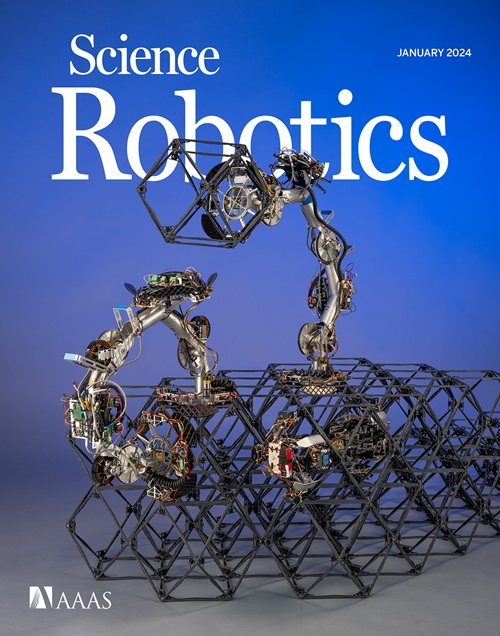增强康复机器人与脊髓神经调节:概念的证明
IF 27.5
1区 计算机科学
Q1 ROBOTICS
Science Robotics
Pub Date : 2025-03-12
引用次数: 0
摘要
康复机器人旨在促进神经系统的活动依赖性重组。然而,瘫痪患者在机器人辅助康复期间无法产生足够的活动,因此无法从这些治疗中获益。在这里,我们开发了一种可植入的脊髓神经假体,在机器人设备的辅助下,在闭环中操作,以促进行走和骑自行车时的强健活动。这种神经假体与设备无关,设计用于非专业用户的无缝实现。对瘫痪患者的初步评估表明,在机器人辅助行走和骑自行车时,神经假体使肌肉活动的组织模式良好。一项概念验证研究表明,由神经假体增强的机器人辅助康复促进了神经系统的持续改善。此外,神经假体增加了户外休闲步行和骑自行车的活动。未来的临床试验必须在更广泛的人群中证实这些发现。本文章由计算机程序翻译,如有差异,请以英文原文为准。
Augmenting rehabilitation robotics with spinal cord neuromodulation: A proof of concept
Rehabilitation robotics aims to promote activity-dependent reorganization of the nervous system. However, people with paralysis cannot generate sufficient activity during robot-assisted rehabilitation and, consequently, do not benefit from these therapies. Here, we developed an implantable spinal cord neuroprosthesis operating in a closed loop to promote robust activity during walking and cycling assisted by robotic devices. This neuroprosthesis is device agnostic and designed for seamless implementation by nonexpert users. Preliminary evaluations in participants with paralysis showed that the neuroprosthesis enabled well-organized patterns of muscle activity during robot-assisted walking and cycling. A proof-of-concept study suggested that robot-assisted rehabilitation augmented by the neuroprosthesis promoted sustained neurological improvements. Moreover, the neuroprosthesis augmented recreational walking and cycling activities outdoors. Future clinical trials will have to confirm these findings in a broader population.
求助全文
通过发布文献求助,成功后即可免费获取论文全文。
去求助
来源期刊

Science Robotics
Mathematics-Control and Optimization
CiteScore
30.60
自引率
2.80%
发文量
83
期刊介绍:
Science Robotics publishes original, peer-reviewed, science- or engineering-based research articles that advance the field of robotics. The journal also features editor-commissioned Reviews. An international team of academic editors holds Science Robotics articles to the same high-quality standard that is the hallmark of the Science family of journals.
Sub-topics include: actuators, advanced materials, artificial Intelligence, autonomous vehicles, bio-inspired design, exoskeletons, fabrication, field robotics, human-robot interaction, humanoids, industrial robotics, kinematics, machine learning, material science, medical technology, motion planning and control, micro- and nano-robotics, multi-robot control, sensors, service robotics, social and ethical issues, soft robotics, and space, planetary and undersea exploration.
 求助内容:
求助内容: 应助结果提醒方式:
应助结果提醒方式:


